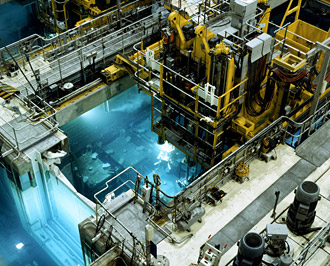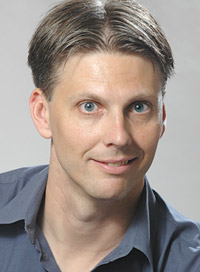Rethinking nuclear power
What's the first thing you think of when you hear the word nuclear? Mushroom clouds? Three Mile Island's reactor towers surrounded by swirling steam? Chilling memories of your school's air raid drills during the Cold War?

Think again. Nuclear is back, big time. With climate change concerns escalating, fossil fuel supplies diminishing and electricity consumption expected to double in 10 years, nuclear has regained some of its lost luster.
After a four-decade hiatus without major U.S. investment, new reactors are in the works in four states, backed by federal loan guarantees. High-profile environmentalists Stewart Brand, Steve Kirsch and James Lovelock are stumping for nuclear. The Department of Energy (DOE) is launching a research hub to develop modeling and simulation tools for nuclear reactors and is tapping brilliant minds-like Berkeley engineers Per Peterson and Brian Wirth-to get the nation back on track with the one technology they say could help build an independent, low-carbon supply to meet future energy needs.
"The 104 nuclear plants now in operation represent the largest source of carbon-free electricity in the country," says Wirth, associate professor of nuclear engineering. "The nuclear pendulum is swinging back, but we have to work really hard because, in some cases, we've let the technology go dormant."
In the 1970s as many as 10 plants were being built at one time. Then, the 1979 accident at Three Mile Island (TMI), along with cost overruns, stopped the industry cold; 20 years later, U.S. plants were still running at limited capacity. Fears linger in many who associate anything nuclear with the destruction wreaked in two Japanese cities by a powerful force that yields energy seven orders of magnitude greater than fossil fuels. Around such emotionally charged issues, Wirth says, navigating the policies and politics of nuclear power is even more challenging than the engineering itself.

"With the safety systems and containment measures they have in place, it is not feasible to have an explosive release of nuclear radiation in western nuclear power plants," he argues, addressing concerns about safety and security at U.S. plants. TMI's partial meltdown did not cause a significant release of radioactivity, he adds, and the Chernobyl accident seven years later involved a different reactor design, where technicians had turned off all safety systems to run a test.
On the question of radioactive materials disposal, nuclear is not the only power source that produces waste. Toxic emissions generated by burning fossil fuels cause three million deaths worldwide each year, according to the World Health Organization, with 20,000 in the United States alone. And a single coal power plant releases 100 times the radiation of a nuclear power plant of the same wattage.
"There's a growing recognition," Wirth says, "that the volume of nuclear waste we're talking about is really quite small compared with the carbon emitted from other technologies."
A key element of U.S. policy now is to ensure that existing plants are operating safely and effectively at about 90 percent capacity, he says. The Nuclear Regulatory Commission licensed most plants for only 40 years. Now researchers are working on ways to upgrade them to produce more energy and extend their lifespan from 40 to 60 years and beyond. This is accomplished by replacing components like fuel assemblies, aboveground piping and steam generators, then storing onsite any materials that have picked up radioactivity. Many new plants are planned next to existing plants, where nuclear and electricity infrastructure already exists.
"You build your infrastructure in such a way that, when unit one is retired, you have units two, three and four right next to it," Wirth says. In his work with Argonne National Laboratory for the DOE research hub, he is using high-fidelity computation modeling to better understand the performance of nuclear fuels and materials. This is a critical step to ensure that upgrades can optimize plant performance without pushing the limits of safety.

The big buzz in nuclear circles, Wirth says, is advanced reactor design. As opposed to the light-water design used in existing fission reactors, many of the proposed fourth-generation nuclear reactors will use a closed fuel cycle, which some say could increase uranium efficiency from a few percentage points to in excess of 90 percent, essentially destroying more radioactive waste than it produces. Further in the future, fusion reactors offer the potential to produce electricity with even less radioactive waste generation.
But with these designs an estimated 20 to 40 years off, radioactive waste management is still the dark cloud hanging over nuclear. After terminating the controversial Yucca Mountain Repository plan, the Obama administration appointed a 15-member blue ribbon commission to investigate other options. Serving on that panel is Berkeley's own Per Peterson, professor and chairman of nuclear engineering and an expert in nuclear waste processing. Possible strategies include charging utilities for the amount of nuclear waste they generate to encourage development of improved fuels and recycling technologies. (Currently the U.S. Nuclear Waste Fund fee is charged based on the amount of electricity generated.)
"The optimal thing to do," Wirth says, "is to take our nuclear waste and treat it chemically or through plasma processing to separate out the lighter fission products-which are very radioactive and have much faster decay rates of 500 to 1,000 years-from the transuranics. Then we're left with a problem we could more easily manage." It's the transuranic actinides, Wirth explains, the elements with a higher atomic number than uranium, that will be around for a very long time. But they can be processed into fuel or target materials for reuse in nuclear reactors, where fission will make them less radioactive.
Nuclear power now generates about 20 percent of U.S. electricity. With each plant taking up to six years and $10 billion to build, it could be several generations before nuclear becomes a major player in a low-carbon U.S. energy landscape. But Wirth envisions a future where hydrocarbons are burned for only a few essential applications like trucking and aviation.
"We would have to get 300 to 400 plants up and running, so I don't know if we will get there in my lifetime," Wirth says. "But I would like to see nuclear provide 50 to 60 percent of our electricity, with the other half supplied by renewables. It's a realistic goal, maybe by the end of the century."
Reprinted with permission from Innovations, volume 4, issue 3, April 2010, College of Engineering.
